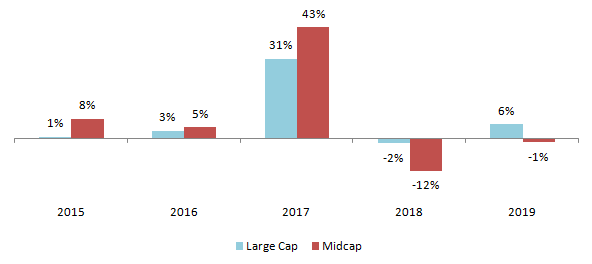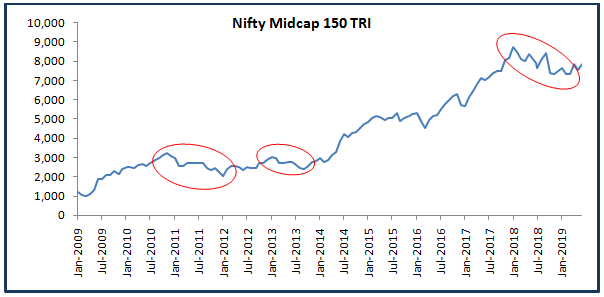What should the ideal tenure of an STP: Midcap Equity Mutual Funds

In our last post on Systematic Transfer Plan (STP), What should the ideal tenure of a STP in Large Cap Mutual Funds, we discussed about the dilemma which investors face when investing in equity mutual funds through STP from liquid or other debt funds. Since STPs are employed in volatile markets, they give best results if the STP tenure coincides the period of volatility or correction. If the tenure is too short, then you will miss out on opportunity of buying mutual fund units at a lower cost. However, if the tenure is too long then you will be purchasing units of equity funds at higher and higher price with every STP instalment.
It is very difficult to predict how much the market will correct or how long volatility will last. Behaviour of the stock market in the past corrections can provide useful guidance to investors for planning their STPs. In the previous post, What should the ideal tenure of a STP in Large Cap Mutual Funds, we looked at the past corrections and saw how STPs of different tenures in a large cap index (Nifty 50) performed in different corrections. We saw that 3 – 6 month STPs give best results for large cap.
Suggested reading: Large cap or mid cap equity mutual funds – which is better in the long run
Midcaps however, tend to be much more volatile than large cap. Midcaps also tend to recover faster than large caps. The chart below shows average annual returns of large cap and midcap funds categories.

In this blog post, we will discuss what STP tenures give better results for midcap funds based on performances in historical market cycles (corrections and recoveries).
Historical corrections
For midcaps we have chosen Nifty Midcap 150 TRI (covering all the midcap stocks) as our benchmark index. Let us look at the major correction in the midcap index over the past 10 years. There were two major corrections (20% or more) in midcaps over the last 10 years (please see the portion of the Nifty Midcap 150 TRI chart circled in red). The correction beginning at the end of 2010 lasted for around 12 months, while the correction in 2013 lasted for around 9 months. The most recent correction in midcaps began in January 2018 and lasted more than a year. Even though midcaps recovered from the bottom, the midcap index continues to be quite volatile and the recovery is not very convincing.

How are midcap corrections different from large cap?
The Nifty fell by 20 – 25% in the two major corrections in the last 10 years (refer to our post, What should the ideal tenure of a STP in Large Cap Mutual Funds). In the case of midcaps, the Nifty Midcap 100 TRI fell by 37% in 2011 and 21% in 2013. If we go back further in history, midcaps saw a much deeper correction compared to large caps in 2008. Therefore, we can infer that midcap corrections tend to be deeper than large cap and therefore, STP benefits can be significantly higher for midcaps in terms of reducing the acquisition cost of units. However, midcap corrections also tend to last longer than large cap. Take the example of correction in 2018. Nifty recovered much faster and made an all time high, while Nifty Midcap 150 is still significantly lower than its all time high. STPs in midcap should take the length of volatile market conditions into consideration.
Suggested reading: Large cap Midcap or value funds – where should you invest now?
How would STPs of different tenures have performed during these two corrections?
Let us assume you had Rs 10 Lakhs lump sum funds. When the market corrected 20% in 2011 and 2015 - 16, you invested the amount in a liquid fund and transferred equal amounts every month to Nifty Midcap 150 TRI over 3 different STP tenures 3 months, 6 months and 12 months. For the sake of simplicity let us assume you get 6% annualized returns from your liquid fund. First let us see how much returns we would have accrued from the liquid fund over different STP tenures (assumption the first STP instalment to equity fund is debited on the lump sum investment date).

Let us now see how many Nifty Midcap 150 units you would have been able to purchase over different STP tenures during the 2011 correction and their values 3 years later. We are assuming the liquid fund returns are re-invested in the Nifty Midcap 150 TRI. Please note that we begin our STP when the market has corrected 20% from its previous peak.
Investment Start Date: 1st February 2011

Source: NSE Data
Clearly by spreading out your STP over 12 months, you were able to take the maximum advantage of price correction in midcaps during the year. Let us now see how many Nifty Midcap 150 units you would have been able to purchase over different STP tenures during the 2013 correction and their values 3 years later. Again, please note that we begin our STP when the market has corrected 20% from its previous peak.
Investment Start Date: 2nd September 2013

Source: NSE Data
The results are exactly the opposite when we compare with the previous correction. 3 month STP gives significantly better result than 6 months and 12 months STP. Based on these two examples, we cannot definitively say whether a short tenure (3 months) STP is better than a long tenure (12 months) STP or vice versa. But the conflicting results provide valuable investing lessons for us.
What we learnt and our take
In our post, What should the ideal tenure of a STP in Large Cap Mutual Funds, we saw that short tenure STPs (3 – 6 months) work better than long tenure STPs. In midcaps, we cannot say with any degree of conviction, whether short tenures will be better for STP or vice versa. This is because midcaps are much more volatile and therefore, short term price movements (both corrections and recoveries) are difficult to predict.
In 2011, the short to medium term correction lasted longer and the recovery was slower. In 2013, the correction was relatively shorter and recovery was much fuelled by the pre-election rally in anticipation of NDA win in the 2014 Lok Sabha elections. The 2018 – 19 correction in midcaps is different from the previous two corrections. The recent correction is not as deep as 2011, but unlike 2014 both the pre-election and post election rallies midcaps was subdued, even though we had a repeat of 2014 Lok Sabha election results in 2019 (in fact, a bigger majority for BJP in 2019).
Since the depth and length of corrections in midcap are difficult to predict, in our view, you should err on the side of conservativeness and opt for long STP tenures in midcap funds. Mutual Fund STPs are wonderfully flexible plans; if you feel convinced that recovery is underway and the market sentiment is positive, you have the option of discontinuing or stopping your STP by sending a written request to the asset management company (fund house) or the registrar / transfer agent (RTA) your fund house is associated with. You can then switch the balance amount from your liquid fund to the equity fund. If you remain concerned about volatility, you can continue your STP. If you need guidance about STP, you should consult with your financial advisor.
Mutual Fund Investments are subject to market risk, read all scheme related documents carefully.
RECOMMENDED READS
LATEST ARTICLES
- Why you need to have hybrid mutual funds in your portfolio: Different types of funds Part 2
- Why you need to have hybrid mutual funds in your portfolio: Misconceptions Part 1
- Which is the best time to invest in mutual funds
- Economic slowdown: Is it real and what should you do
- Importance of liquidity in investing: Mutual funds are ideal solutions
An Investor Education Initiative by ICICI Prudential Mutual Fund to help you make informed investment decisions.
Quick Links
Follow ICICI Pru MF
More About ICICI Pru MF
POST A QUERY




